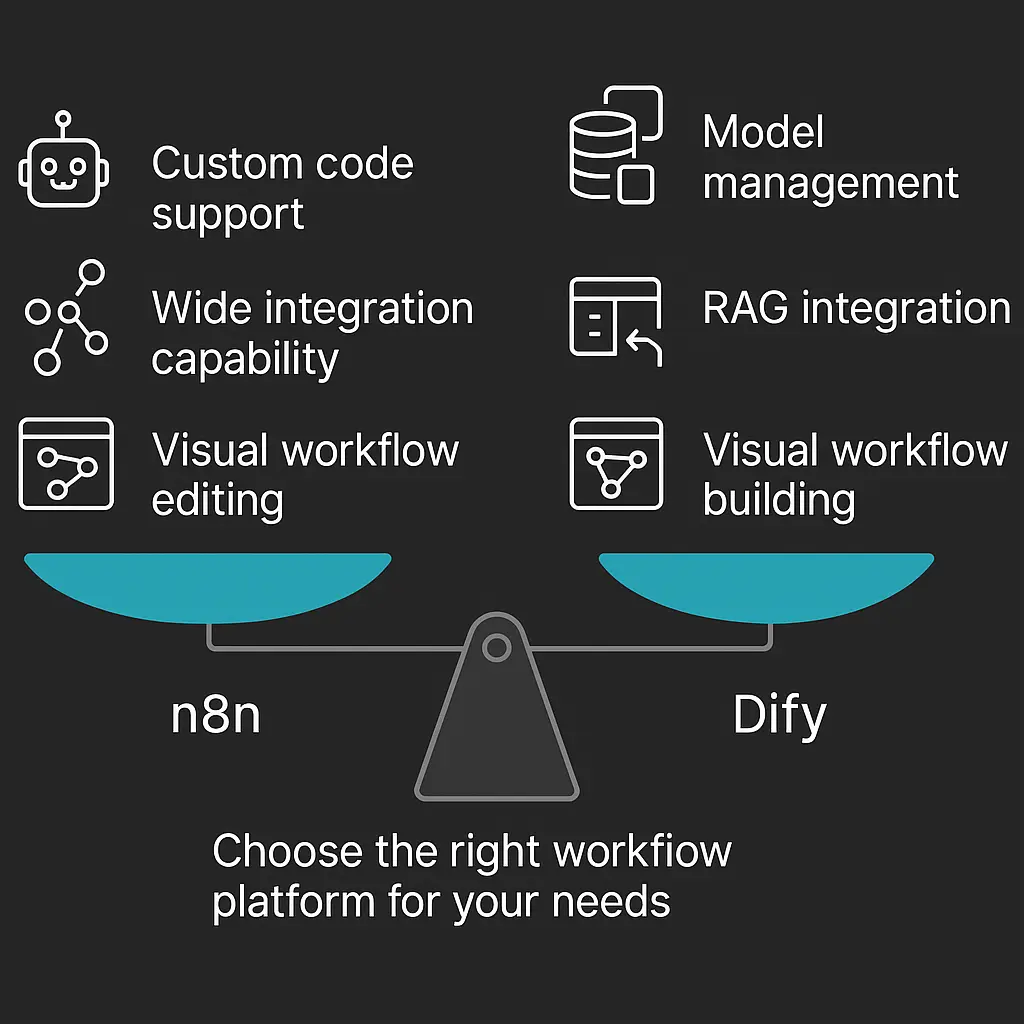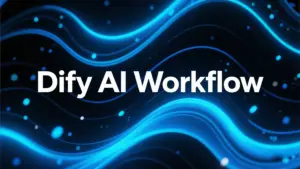Practical comparison for developers and product teams: Explore the application scenarios and advantages of n8n and Dify in AI workflow automation.
In today's rapidly evolving technological landscape, enterprises and developers are confronted with increasingly complex tasks and processes. Manual operations, whether for data processing, API integration, or AI model deployment and management, are not only inefficient but also prone to errors. To address these challenges, AI-powered workflow automation platforms have emerged, offering visual simplification of processes that enhance productivity and accuracy.
This guide compares n8n vs Dify, two leading platforms in the realm of AI for workflow automation. It aims to assist developers and product teams in selecting the most suitable enterprise generative AI platform for building intelligent and scalable workflows.

n8n: A Flexible Open-Source AI Powered Workflow Automation Platform
n8n is an open-source workflow automation tool designed for technical teams, offering high flexibility and scalability. Its core features include:
- Visual Editor: Build workflows by dragging and dropping nodes, where each node represents an operational step.
- Extensive Integration: Comes with over 400 pre-configured integrations, supporting connections with various APIs and services.
- Custom Code Support: Allows writing JavaScript or Python code within nodes to achieve more complex logic when needed.
- AI Capability Integration: Integrates with AI frameworks like LangChain, supporting the construction of intelligent agents based on large language models.
- Deployment Flexibility: Supports both local and cloud deployment to meet different enterprise security and compliance needs.
n8n is suitable for scenarios requiring high customization and complex logic, such as data pipeline construction, API orchestration, and automated testing.

Dify Workflow: A Workflow Platform Focused on Generative AI Applications for Enterprise
Dify is an open-source enterprise generative AI platform that simplifies the design, deployment, and operation of AI-powered workflows based on large language models (LLMs).Its main features include:
- Visual Workflow Builder: Construct the logic flow of AI applications through drag-and-drop, lowering the development threshold.
- RAG Engine Integration: Built-in Retrieval-Augmented Generation capabilities support the construction and querying of knowledge bases.
- Model Management: Supports access and management of various open-source and commercial large models.
- Multimodal Support: Handles various data types, including text and images.
- Quick Deployment: Offers one-click deployment functionality for quickly launching AI applications.
Dify is ideal for scenarios that require rapid construction and iteration of generative AI applications, such as intelligent customer service, content generation, and knowledge Q&A.

Core Capabilities of n8n vs Dify: Choosing the Right AI Workflow Automation Platform for Your Project
Many developers wonder: Both n8n and Dify support workflows and drag-and-drop functionality, so which should I choose? In fact, their design goals and core capabilities differ significantly. Let's break it down:
1. Application Positioning: General vs. Specialized
| Comparison Dimension | n8n | Dify |
|---|---|---|
| Positioning | General automation platform | AI application workflow platform |
| Target Audience | Data engineering, SaaS integration | Generative AI, LLM applications |
| Workflow Core | Nodes + conditional logic | Prompt + RAG + model response |
| User Group | Technical personnel / automation engineers | AI application developers / product teams |
Summary:
- If you're working on "business automation integration" → Choose n8n
- If you're building "AI intelligent applications" → Dify is more enjoyable!
2. Functional Focus Differences
| Function Category | n8n | Dify |
|---|---|---|
| Visual Builder | ✅ Supports conditional logic, loops, variables, etc. | ✅ Supports branching, model invocation, context control |
| Supported Model Types | ✅ Requires manual configuration for model invocation (e.g., OpenAI API) | ✅ Supports OpenAI, Claude, Qwen, DeepSeek by default |
| Built-in AI Capabilities | ❌ (Requires additional plugins) | ✅ Integrates RAG, Function-Call, tool invocation |
| Workflow Types | ✅ General processes (data import, WebHook, scheduled) | ✅ LLM-driven processes (Prompt + Response) |
| Plugin Ecosystem | ✅ Over 400+ plugins, supports REST, Webhook, etc. | Fewer plugins, but integrates mainstream AI tools |
Example:
- With n8n, you can achieve:
- "Whenever an email with a quote is received → Automatically extract customer name → Write to database → Notify sales via Slack"
- With Dify, you can achieve:
- "Customer asks about product warranty → Retrieve from knowledge base via RAG → Automatically respond + Log inquiry history in CRM"
These two are not in the same "class" but rather belong to "AI specialization" and "information technology engineering class."
3. Development Flexibility & Technical Threshold
| Technical Dimension | n8n | Dify |
|---|---|---|
| Custom Code Support | ✅ Supports JS/TS programming within nodes | ⚠️ Workflow currently does not support JS, more configuration-based |
| API Capability | ✅ Can act as an API gateway, automatically generate Webhook | ✅ Provides SDK and API for embedding in business systems |
| Plugin Development | ✅ Comprehensive Node development standards | Plugin ecosystem is in early stages, API flexibility is slightly lower |
| Model Management Capability | ❌ Does not include model lifecycle management | ✅ Supports model switching, versioning, context injection |
Developer Suggestions:
- If you're a DevOps/backend/automation engineer → Prefer writing logic scripts directly → Choose n8n
- If you're more focused on Prompt orchestration, AI Agent, fine-tuning model responses → Choose Dify
4. Usability Comparison
| Usability Dimension | n8n | Dify |
|---|---|---|
| UI Friendliness | ✅ Clear node diagrams, supports large screen editing | ✅ AI Prompt toolchain layout is clear, more "low-code" experience |
| Documentation Completeness | ✅ Multilingual support + complete plugin documentation | ✅ Excellent Chinese support, quick start for AI projects |
| Community Ecosystem | Very active, GitHub Star 42k+ | Rapidly growing, high heat in the AI community |
| Getting Started Cost | ⚠️ Has a learning curve (understanding workflows, debugging) | ✅ Relatively smooth (e.g., configuring GPT + inserting knowledge base) |
Summary:
- n8n is like an "open-source Zapier + Node-RED":
Versatile, but requires writing some logic and mastering certain automation thinking - Dify is more like an "out-of-the-box LLM workflow manager":
Complete with Prompt, RAG, and model management, perfect for those focused on generative AI
Scenario Recommendations: Which is More Suitable for Your Project?
Don't let "platform selection" become a technical debate within your team. Let's quickly determine based on typical business scenarios:
| Business Scenario | Recommended Platform | Reason |
|---|---|---|
| Build internal enterprise automation (Email → CRM → Reporting) | ✅ n8n | Many plugins, strong process control |
| Quickly launch an intelligent Q&A bot | ✅ Dify | Model management + knowledge base + Chat interface all-in-one solution |
| Integrate AI features into existing systems (e.g., ERP) | n8n + Dify (combined) | n8n controls business logic, Dify manages model invocation |
| Build multi-turn dialogue AI Copilot (with memory) | ✅ Dify | Supports context + Function invocation |
| Export data from the database every hour → Send email | ✅ n8n | Can be scheduled + strong data processing capability |

Can Dify + n8n Be Used Together?
The answer is: Absolutely, and highly recommended!
By combining Dify's generative AI workflow orchestration with n8n's robust automation engine, teams can create truly intelligent and scalable AI-powered workflow solutions for modern enterprises.
Imagine such an AI workflow linkage diagram:
graph TD; A[User Question Input] -->|Webhook| Dify["AI Application: RAG + GPT"] Dify -->|Return Structured Response| n8n[Business Automation] n8n --> CRM[Write to Customer Database] n8n --> Email[Notify Relevant Personnel]
Simply put:
• Dify is responsible for "Generating Answers" + "Understanding Intent"
• n8n is responsible for "Executing Actions" + "Implementing Business Processes"
Using them together is more flexible than using them separately, one is the AI brain, the other is the automation muscle.
Technical Selection Advice: Decision Flowchart
flowchart TD Start["What is your project goal?"] --> AI["Building an AI application or Q&A system?"] AI -->|Yes| UseDify["Dify is the best choice"] AI -->|No| Auto["Need to handle API/scheduling/database?"] Auto -->|Yes| UseN8n["n8n is more suitable"] Auto -->|No| Combo["Consider Dify + n8n linkage"] UseDify --> END["Go build an AI Copilot!"] UseN8n --> END Combo --> END
Recommended Reading
- [How Dify is Transforming Workflow Automation in Document Review]
- [ A Case Study of A Medical Company with Dify]
- [ What’s the Difference Between Dify Agent and Dify Workflow?]
If you're ready to leverage the power of AI in your workflow automation, we offer comprehensive services to help you implement and optimize these platforms by ZedAIoT Platform for your specific needs. Contact us today to learn how we can assist you in transforming your processes and enhancing your operational efficiency.



